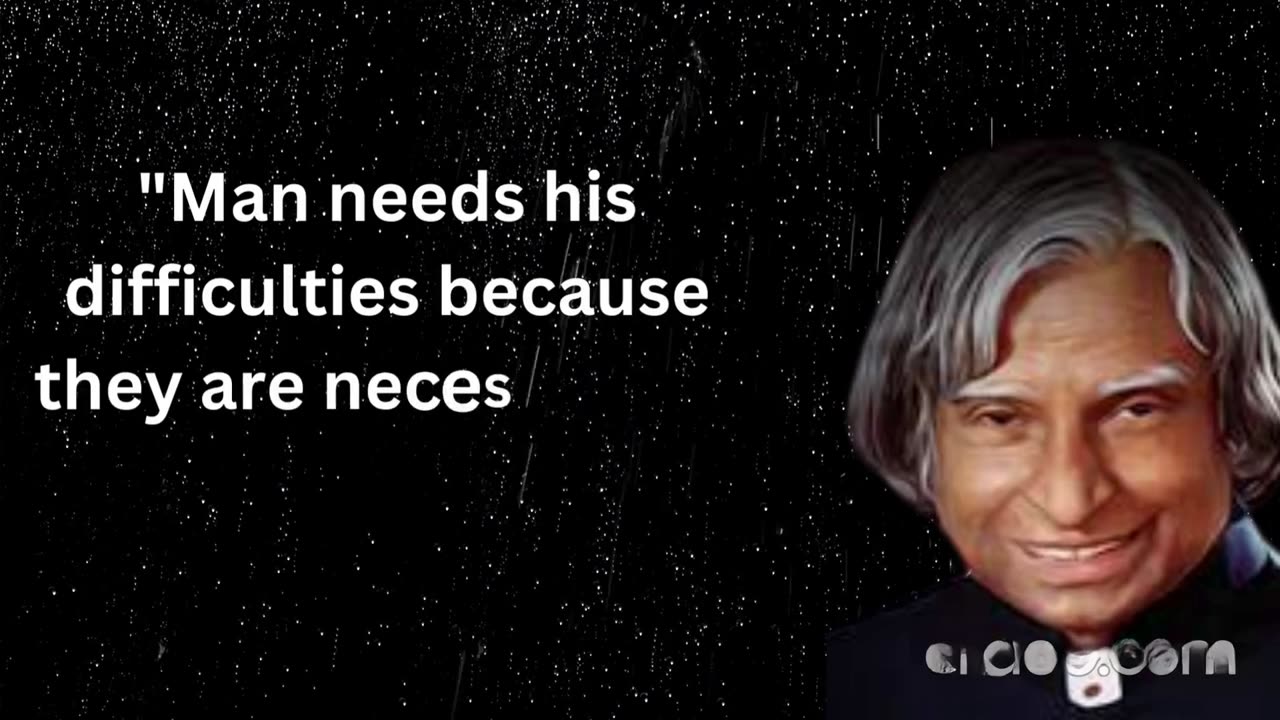Premium Only Content

A.P.J Abdul Kalam Quotes worth listening to.
Avul Pakir Jainulabdeen Abdul Kalam BR (/ˈɑːbdəl kəˈlɑːm/ ⓘ; 15 October 1931 – 27 July 2015) was an Indian aerospace scientist and statesman who served as the 11th president of India from 2002 to 2007. He was born and raised in Rameswaram, Tamil Nadu and studied physics and aerospace engineering. He spent the next four decades as a scientist and science administrator, mainly at the Defence Research and Development Organisation (DRDO) and Indian Space Research Organisation (ISRO) and was intimately involved in India's civilian space programme and military missile development efforts.[1] He thus came to be known as the Missile Man of India for his work on the development of ballistic missile and launch vehicle technology.[2][3][4] He also played a pivotal organisational, technical, and political role in India's Pokhran-II nuclear tests in 1998, the first since the original nuclear test by India in 1974.[5]
Kalam was elected as the 11th president of India in 2002 with the support of both the ruling Bharatiya Janata Party and the then-opposition Indian National Congress. Widely referred to as the "People's President",[6] he returned to his civilian life of education, writing and public service after a single term. He was a recipient of several prestigious awards, including the Bharat Ratna, India's highest civilian honour.
While delivering a lecture at the Indian Institute of Management Shillong, Kalam collapsed and died from an apparent cardiac arrest on 27 July 2015, aged 83.[7] Thousands, including national-level dignitaries, attended the funeral ceremony held in his hometown of Rameswaram, where he was buried with full state honours.[8]
Early life and education
Avul Pakir Jainulabdeen Abdul Kalam was born on 15 October 1931, to a Tamil Muslim family in the pilgrimage centre of Rameswaram on Pamban Island, then in the Madras Presidency and now in the State of Tamil Nadu. His father Jainulabdeen Marakayar was a boat owner and imam of a local mosque;[9] his mother Ashiamma was a housewife.[10][11][12][13] His father owned a ferry that took Hindu pilgrims back and forth between Rameswaram and the now uninhabited Dhanushkodi.[14][15] Kalam was the youngest of four brothers and one sister in his family.[16][17][18] His ancestors had been wealthy Marakayar traders and landowners, with numerous properties and large tracts of land. Marakayar are a Muslim ethnic group found in coastal Tamil Nadu and Sri Lanka who claim descent from Arab traders and local women. The family business had involved trading groceries between the mainland and the island and to and from Sri Lanka, as well as ferrying pilgrims between the mainland and Pamban. With the opening of the Pamban Bridge to the mainland in 1914, however, the businesses failed and the family fortune and properties were lost by the 1920s, apart from the ancestral home. The family was poverty-stricken by the time Kalam was born. As a young boy he had to sell newspapers to add to the family's meager income. [19][20][21]
In his school years, Kalam had average grades but was described as a bright and hardworking student who had a strong desire to learn. He spent hours on his studies, especially Mathematics.[21] After completing his education at the Schwartz Higher Secondary School, Ramanathapuram, Kalam went on to attend Saint Joseph's College, Tiruchirappalli, then affiliated with the University of Madras, from where he graduated in physics in 1954.[22] He moved to Madras in 1955 to study aerospace engineering in Madras Institute of Technology.[13] While Kalam was working on a senior class project, the Dean was dissatisfied with his lack of progress and threatened to revoke his scholarship unless the project was finished within the next three days. Kalam met the deadline, impressing the Dean, who later said to him, "I was putting you under stress and asking you to meet a difficult deadline."[23] He narrowly missed achieving his dream of becoming a fighter pilot, as he placed ninth in qualifiers, and only eight positions were available in the IAF.[24]
-
 15:24
15:24
Degenerate Jay
21 hours ago $0.11 earned5 Best Moments In Batman: Arkham Asylum
14K -
 12:24
12:24
The Shannon Joy Show
14 hours ago🔥From Flock Cameras to Palantir: America’s Expanding Digital Cage🔥
11.8K2 -
 LIVE
LIVE
BEK TV
23 hours agoTrent Loos in the Morning - 8/27/2025
209 watching -
 LIVE
LIVE
The Bubba Army
22 hours agoTaylor Swift & Travis Kelce ENGAGED! - Bubba the Love Sponge® Show | 8/27/25
1,673 watching -
 40:14
40:14
Uncommon Sense In Current Times
17 hours ago $2.57 earnedThe Dating Crisis in America | J.P. De Gance on the Church’s Role in Restoring Family & Faith
47.1K3 -
 12:35
12:35
Red Pill MMA
19 hours agoNow We Know The Truth.. Hero Who Stopped Raja Jackson Speaks Out
18.1K8 -
 41:04
41:04
Coin Stories with Natalie Brunell
1 day agoCooking, Culture & Crypto: Norma Chu’s Food Empire Turns Bitcoin Treasury
18.3K -
 8:03
8:03
MattMorseTV
18 hours ago $9.35 earnedThings in the UK just got INSANE...
98.2K139 -
 3:02:10
3:02:10
daniellesmithab
13 hours agoAlberta Next: Fort McMurray Town Hall
24.4K1 -
 2:11:17
2:11:17
Side Scrollers Podcast
21 hours agoINSANE Illegal Migrant Propaganda Xbox Game + Paypal REFUSES To Pay Dev + More | Side Scrollers
71.6K5